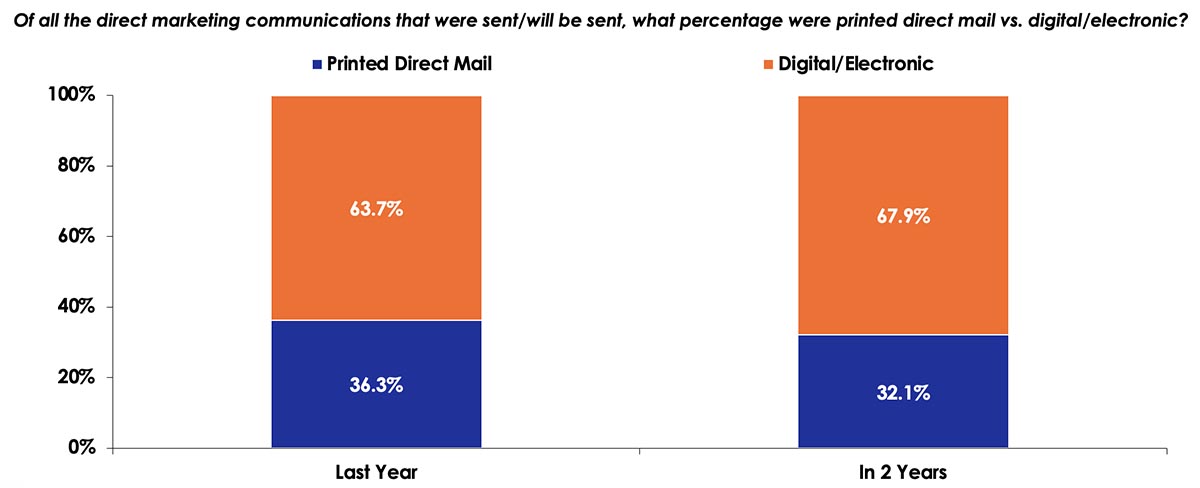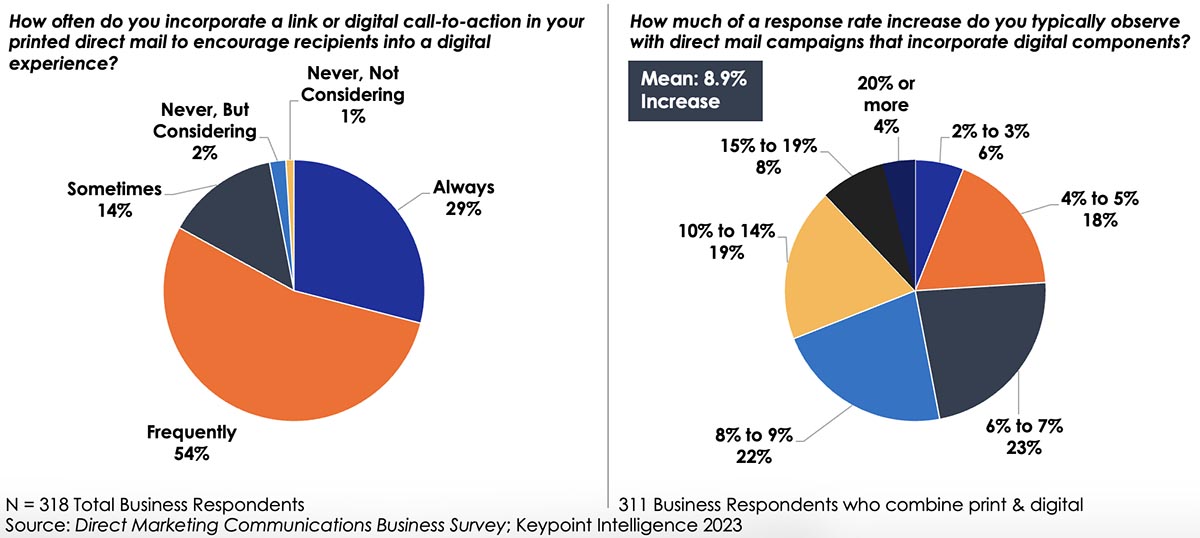- All respondents worked for firms with at least 500 employees, but the average was about 3,500.
- Last year, the percentage share of printed direct mail vs. digital communications was estimated at about 36% vs. 64%. In two years’ time, businesses still expect nearly a third of their marketing communications to be printed and mailed.
- Firms reported a 9% increase in response rates with print campaigns that included digital links.
By Eve Padula
Introduction
Providers of marketing communications—messages that are sent to promote a brand/product/service or develop a relationship—are seeking ways to differentiate themselves from the competition and further engage their customers. Consumers’ communication preferences are evolving all the time, and businesses must remain nimble and responsive to these shifts if they hope to retain existing customers, attract new ones, and improve the overall customer journey.
Keypoint Intelligence recently conducted its 2023 direct marketing communications primary research to better understand how businesses’ direct marketing practices are changing over time as they strive to meet their customers’ needs. Over 300 business leaders qualified for participation in this research, and all respondents worked in marketing or customer experience roles. This article offers a brief overview of the top-level results from this year’s survey. It discusses the transition to paperless communications, the ongoing focus on customer experience, and how business marketing practices are changing over time.
General Survey Findings
In total, 318 senior-level business professionals responded to our 2023 research. Although respondents operated within a wide range of vertical industries, nearly half (47%) were e-commerce and/or brick and mortar retailers. All worked for companies with at least 500 employees, but the overall mean number of employees was about 3,500. When the results were separated by vertical industry, telecommunications/utilities respondents had the fewest employees while banking/financial services respondents had the most.
Figure 1: Number of Employees

N = 318 Total Business Respondents
Source: Direct Marketing Communications Business Survey; Keypoint Intelligence 2023
The shift toward digital communications is undeniable, with the vast majority of respondents (93%) having an official policy or strategy to reduce/eliminate the use of printed and mailed direct marketing communications. Despite this shift, nearly all respondents were still sending some printed direct mail to customers or prospects via the US Postal Service (USPS). Last year, the percentage share of printed direct mail vs. digital communications was estimated at about 36% vs. 64%. Even in two years’ time, businesses expect nearly a third of their marketing communications to be printed and mailed.
Figure 2: Direct Mail vs. Digital Communications—Current & Future

N = 318 Total Business Respondents
Source: Direct Marketing Communications Business Survey; Keypoint Intelligence 2023
Business respondents appreciate the efficacy and ongoing appeal of traditional direct mail among consumers. They also recognize that printed and digital communications can be combined for better engagement and an improved experience. A strong majority of respondents (83%) always or frequently included a call to action with their printed direct mail to pull the recipient into a digital experience. What’s more, those who were combining print and digital reported an almost 9% increase in response rates with print campaigns that included digital links. Along with providing a tactile experience that many consumers enjoy, printed direct mail plays well with digital channels.
Figure 3: Combining Digital Components with Printed Communications

It is now more important than ever for brands to enhance their marketing with cross-media campaigns, while also developing a clearly targeted omni-channel strategy to capture consumers’ attention. Businesses understand the importance of marketing across multiple channels, but multi-channel marketing can still be a struggle. Among this year’s survey participants, the top challenges associated with running marketing campaigns across multiple channels included choosing the best channel(s), using customer data to personalize the message, and keeping the message consistent across all channels.
The Bottom Line
Today’s brands recognize that when it comes to communication channels, honoring consumers’ preferences is paramount to a positive experience and continued loyalty. The key message is that consumer preferences are changing all the time and will often differ from one customer to the next. The march toward digital is undeniable, but print has a role to play too. Brands must get to know their customers on an individual level so they can continue to deliver the right communications, in the right format, at the right time, and with the right frequency.
In addition to the top-level findings highlighted here, our new direct marketing business research covers data privacy/regulations, the role of outsourcing, and artificial intelligence (AI). Survey results are broken out by vertical industry, number of employees, and marketing budget. If you’re interested in learning more about our in-depth research, you can contact us by clicking here.
Eve Padula is a Senior Consulting Editor for Keypoint Intelligence's Production Printing team with a focus on Business Development Strategies, Customer Communications, and Wide Format. She is responsible for the production and distribution of many types of deliverables, including forecasts, industry analyses, and research/multi-client studies. She also manages the editing, formatting, and delivery cycles for various types of content.













